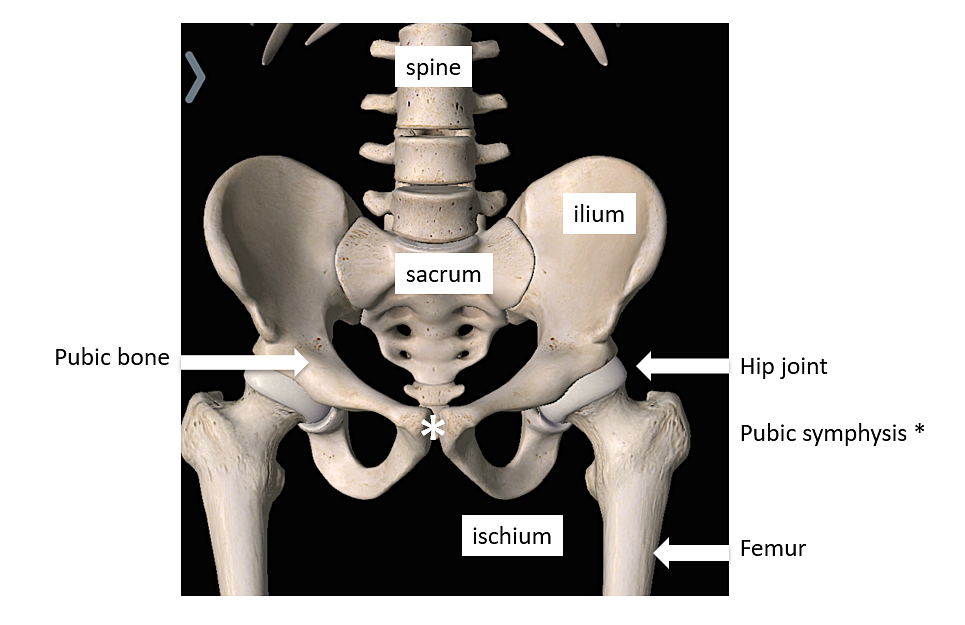In March, World Superbike rider Eugene Laverty crashed his Aprilia RSV4 in the race in Thailand and then was run over by another rider who could not avoid him. Laverty suffered a broken pelvis and other internal injuries.
It is easy to understand a cleanly broken femur (thigh bone) and a gap between two pieces of a previously single bone. Is a pelvis fracture as simple as that? Not quite, as there are many more pieces that come together to form the pelvis — it is not a single bone at all. How many pieces? How long will a broken pelvis keep you off the bike? Glad you asked!
Parts of the pelvis
The normal pelvis has a small somewhat triangular back part (sacrum) off of which your tailbone (coccyx) hangs. On top of the sacrum is your spinal column and spinal cord. Nerves from the spinal cord travel through the sacrum and out through holes in the bone called foramina. Good to keep that bone intact! The scariest part for Laverty was when he temporarily lost some feeling in his lower body.
The sacrum connects to wings on either side (ilium) that start wrapping around to get towards where your hips live. The top part of the ilium is called the iliac crest. This bone determines the width and flare of your pelvis and hips. Underneath the ilium is the ischium and the ischial tuberosity (the bones on which you sit). Continuing forward, the ischia move upwards and toward the midline and meet with the pubic bone forming the centerpiece of the pelvic ring — the pubic symphysis — the place where both sides meet in the front.

These bones must work together through a series of joints and ligaments to keep you moving and to bear the weight of your torso. A variety of muscles connect to your pelvis and a host of arteries and veins course through there — kind of like one of Lemmy’s creatively wired old Harleys. Injuries to the pelvis can therefore damage bone, ligaments, blood vessels, nerves, and of course, pelvic organs that also live in that space. Major pelvis fractures can be very complex and life-threatening and should be treated in specialized centers. If you have a major pelvis fracture, smaller medical centers will transfer you to a major center with the appropriate expertise. Not all fractures require transfer to a trauma center and not all require surgery, either.
How does the pelvis get broken?
Usually along with a lot of other things, most unfortunately. Big things like your brain, solid organs (liver, spleen, kidneys) and sometimes major blood vessels like the aorta (main artery carrying blood away from your heart to your organs) may be injured, as well, since pelvis fractures indicate that a lot of energy was involved. Most pelvic fractures come from deceleration forces — you were going fast and came to an abrupt stop by impacting something that was not moving — or moving towards you. The more rapidly you stop, and the faster you were going, the more force that is transmitted. Since your pelvis has bones in multiple planes, certain injury patterns are identifiable based on how the force was applied.
These are grouped into front-to-back crush, side-to-side crush and vertical shear. Think pelvis sliding into your tank, car impacting you from the side, and a straddle injury across a Jersey barrier, respectively. The amount of force determines how the pelvis fractures, how many fractures there are, and whether the pelvic ring remains intact or is apart in one of more places.
Plain x-rays are not as precise as CT scans, especially since the CT scans may be reformatted into 3D representations and rotated to enhance visualization of fracture lines in order to determine whether a particular fracture is stable or not. Stable fractures may be painful but can bear weight. Unstable ones cannot bear weight and require internal or external (and sometimes both) stabilization, commonly in the operating room.
Stable versus unstable
Remember the ring? Stable fractures leave the ring intact. Unstable ones, of course, do not. The front part of the ring can come apart at the pubic symphysis or at a more than one break on either side. The back part of the ring most often comes apart at the junction of the sacrum with the iliac bone (sacro-iliac fracture). In fact, a pubic symphysis fracture coupled with bilateral sacro-iliac fractures is called an “open book” pelvis fracture as the pelvis widens since it is unhinged. More rarely, the side wings may themselves fracture.
Unstable fractures often lead to a lot of bleeding, making you unstable (high heart rate and low blood pressure), requiring blood transfusion, and urgent intervention. The key is to reduce the pelvic volume to help control bleeding from torn veins. A variety of devices may be used to “bind” the pelvis, aptly termed “pelvic binders.” Velcro is liberally used as are tightening ties similar to what may be found on some the boots sold on Revzilla.
Tidy little lap in Superpole to put it on the front row of the grid @SMRWorldSBK 😁
— Eugene Laverty (@eugenelaverty) July 7, 2018
•
📸 @wd_jrphoto pic.twitter.com/WWaKChrLPz
Coming back from a pelvis fracture
Major pelvis fractures generally are painful and require lots of care including rehabilitation. Remember that the sides of your pelvis are where your thigh bones connect to it. Therefore, after a major pelvis fracture, your gait may not be the same as it was before the injury, especially if the hip joint was involved in the fracture pattern too. Back pain is common and injured joints may also develop post-traumatic arthritis. Physical therapy is important in recovery, and exercise helps maintain muscular strength, ligament function, and bone mass and density.
How long before you ride again? Well, Laverty was back racing in May and riding well enough in June to finish on the podium at Laguna Seca. But then Laverty can do a lot of things on a motorcycle the rest of us can't. Your results will vary.









